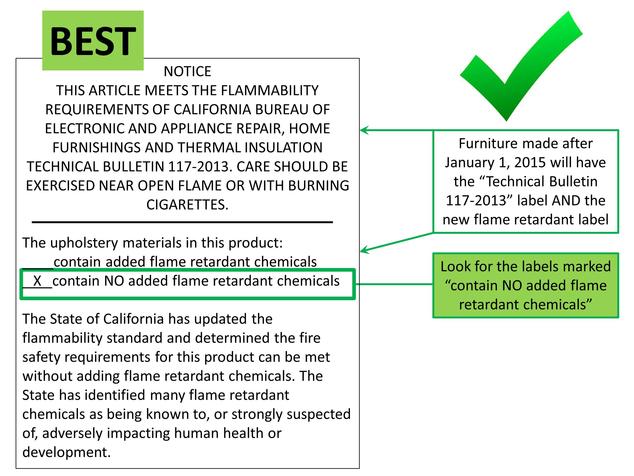Flame retardants should be a top priority when it comes to removing toxic chemicals from your home. Until recently, they have been one of the hardest to avoid, but thankfully it’s easy to find out if your couch, old or new, has flame retardant chemicals.
(You can read more about the science and lack of safety (and efficacy) of flame retardant chemicals here.)
Shopping for a new couch or arm chair? Look for this label

Shopping online? Ask the manufacturer
If you’re in the couch business, you will expect to be asked questions about flame retardants. Customer care representatives will have this information (and the label above) on hand to share with you. Make sure they are sharing information specific to the couch you are purchasing.
How to tell if older or used couches have flame retardants
If the couch was made prior to 2018, it has flame retardant chemicals. Much older couches often contain the most toxic types of retardant chemicals (although this entire class is toxic). Anything after 2018, will have a label outlined above to help you know if it does or does not contain flame retardants.
Off-gassing: Are older couches safer?
Unfortunately, unlike other products, older couches aren’t safer. This is due to the nature of the flame retardant chemicals and what makes them so toxic: persistence. They are part of a class of chemicals that are called PBTs, for their persistence (they stay in the environment and do not break down), bioaccumulation (they build up in the environment) and toxicity (harmful to the developing brain, hormone system and more).
Additional Safety Considerations
- If there isn’t a label on the bottom of the couch or sofa, it’s safe to assume there ARE toxic flame retardants in the product.
- Ask the manufacturer if the couch has been treated with a stain resistant coating, or if flame retardants have been used to treat the fabric. If the answer is yes to either of these questions, ask them for an untreated couch, that does not have any form of flame retardants or fluorinated chemicals.
I know couches are expensive and it’s not something many people can easily switch in their home. If you need time to save up for a new couch, a meaningful way to you can reduce your exposure is through frequently dusting, vacuuming (with a HEPA filter) and washing your hands before eating. Dust is our primary route of exposure for these chemicals and can be managed through day to day cleaning!
(Read more: Seven Ways to Tackle Indoor Air Pollution from Flame Retardants)
Shopping for safer products shouldn’t have to be this complicated. That is why I will continue to advocate for state and federal laws that ban the use of these harmful chemicals, further ensuring that regardless of education, income of access to information, we all will have safer products.
Never miss a post and join my mailing list!
Shop Other Safer Product Categories



